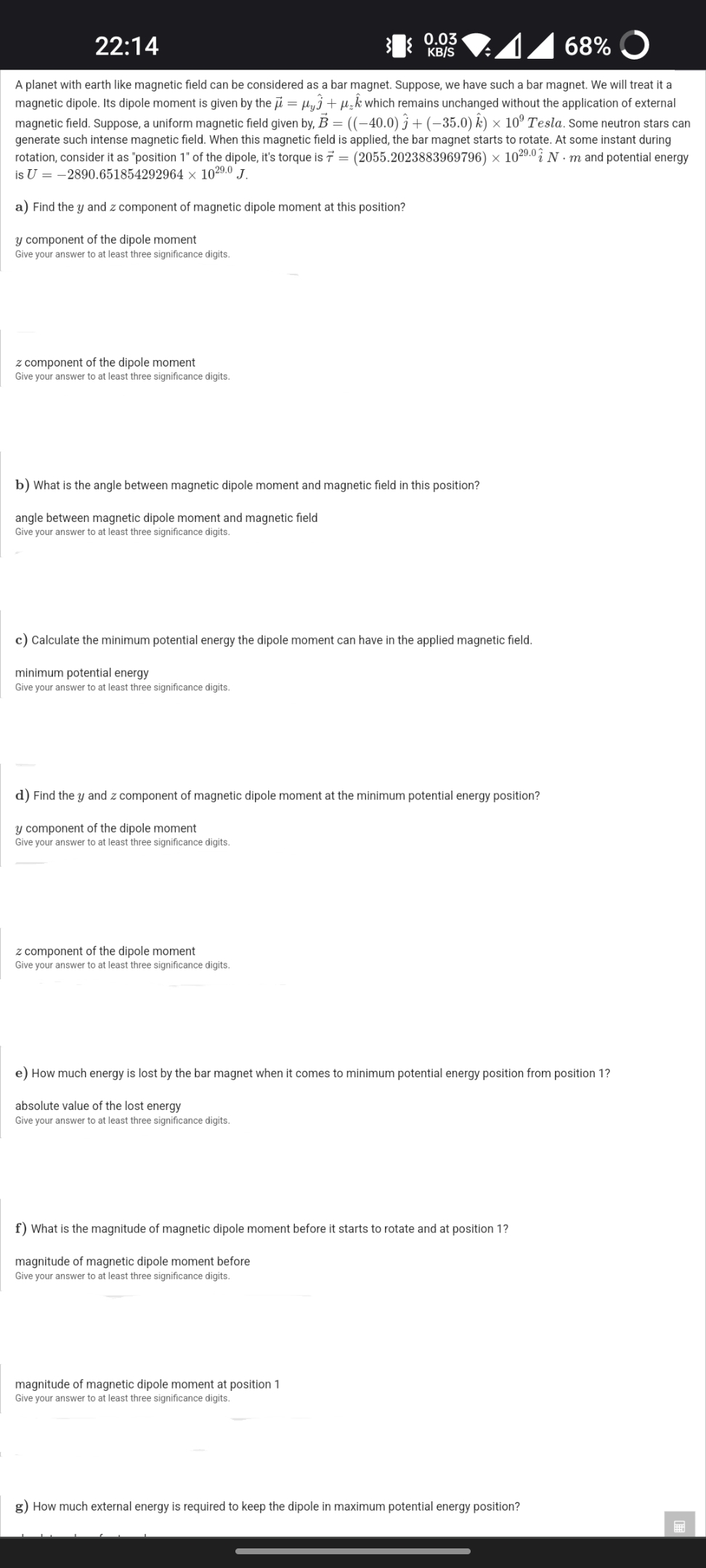College Physics
11th Edition
ISBN:9781305952300
Author:Raymond A. Serway, Chris Vuille
Publisher:Raymond A. Serway, Chris Vuille
Chapter20: Induced Voltages And Inductance
Section: Chapter Questions
Problem 58AP: A spacecraft is in 4 circular orbit of radius equal to 3.0 104 km around a 2.0 1030 kg pulsar. The...
Related questions
Question

Transcribed Image Text:22:14
0.03
KB/S
68% O
A planet with earth like magnetic field can be considered as a bar magnet. Suppose, we have such a bar magnet. We will treat it a
magnetic dipole. Its dipole moment is given by the i = µyj +µ,kwhich remains unchanged without the application of external
magnetic field. Suppose, a uniform magnetic field given by, B = ((-40.0) j + (–35.0) k) × 10° Tesla. Some neutron stars can
generate such intense magnetic field. When this magnetic field is applied, the bar magnet starts to rotate. At some instant during
rotation, consider it as "position 1" of the dipole, it's torque is 7 = (2055.2023883969796) × 10²9.0 i N · m and potential energy
is U = -2890.651854292964 × 1029.0 J.
a) Find the y and z component of magnetic dipole moment at this position?
y component of the dipole moment
Give your answer to at least three significance digits.
z component of the dipole moment
Give your answer to at least three significance digits.
b) What is the angle between magnetic dipole moment and magnetic field in this position?
angle between magnetic dipole moment and magnetic field
Give your answer to at least three significance digits.
c) Calculate the minimum potential energy the dipole moment can have in the applied magnetic field.
minimum potential energy
Give your answer to at least three significance digits.
d) Find the y and z component of magnetic dipole moment at the minimum potential energy position?
y component of the dipole moment
Give your answer to at least three significance digits.
z component of the dipole moment
Give your answer to at least three significance digits.
e) How much energy is lost by the bar magnet when it comes to minimum potential energy position from position 1?
absolute value of the lost energy
Give your answer to at least three significance digits.
f) What is the magnitude of magnetic dipole moment before it starts to rotate and at position 1?
magnitude of magnetic dipole moment before
Give your answer to at least three significance digits.
magnitude of magnetic dipole moment at position 1
Give your answer to at least three significance digits.
g) How much external energy is required to keep the dipole in maximum potential energy position?
Expert Solution
This question has been solved!
Explore an expertly crafted, step-by-step solution for a thorough understanding of key concepts.
Step by step
Solved in 2 steps

Knowledge Booster
Learn more about
Need a deep-dive on the concept behind this application? Look no further. Learn more about this topic, physics and related others by exploring similar questions and additional content below.Recommended textbooks for you

College Physics
Physics
ISBN:
9781305952300
Author:
Raymond A. Serway, Chris Vuille
Publisher:
Cengage Learning

Physics for Scientists and Engineers with Modern …
Physics
ISBN:
9781337553292
Author:
Raymond A. Serway, John W. Jewett
Publisher:
Cengage Learning

Physics for Scientists and Engineers
Physics
ISBN:
9781337553278
Author:
Raymond A. Serway, John W. Jewett
Publisher:
Cengage Learning

College Physics
Physics
ISBN:
9781305952300
Author:
Raymond A. Serway, Chris Vuille
Publisher:
Cengage Learning

Physics for Scientists and Engineers with Modern …
Physics
ISBN:
9781337553292
Author:
Raymond A. Serway, John W. Jewett
Publisher:
Cengage Learning

Physics for Scientists and Engineers
Physics
ISBN:
9781337553278
Author:
Raymond A. Serway, John W. Jewett
Publisher:
Cengage Learning

Principles of Physics: A Calculus-Based Text
Physics
ISBN:
9781133104261
Author:
Raymond A. Serway, John W. Jewett
Publisher:
Cengage Learning

Physics for Scientists and Engineers: Foundations…
Physics
ISBN:
9781133939146
Author:
Katz, Debora M.
Publisher:
Cengage Learning

Physics for Scientists and Engineers, Technology …
Physics
ISBN:
9781305116399
Author:
Raymond A. Serway, John W. Jewett
Publisher:
Cengage Learning